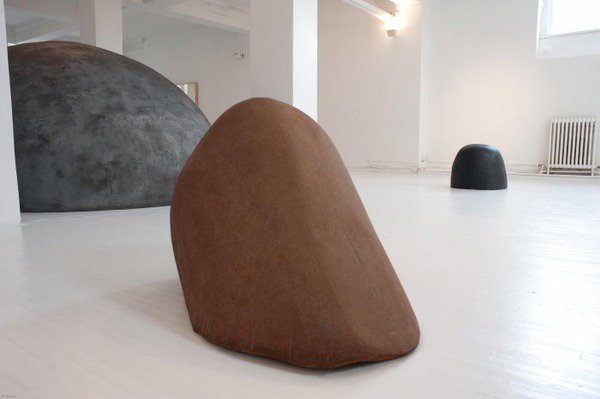Jene Highstein
dal 17/6/2013 al 30/6/2013
Segnalato da
17/6/2013
Jene Highstein
Clocktower Gallery, New York
Early Works. An exhibition of sculpture and drawing by the artist including the recreation of the large-scale Black Mound for Suzi, originally made for P.S.1 Contemporary Art Center's 1976 inaugural exhibition, Rooms.

The Clocktower Gallery presents Jene Highstein: Early Works, an exhibition of sculpture and drawing by Jene Highstein (1942 – 2013). One of the first artists to present work at the Clocktower Gallery, in 1973, Highstein passed away April 27, 2013, at age 70, in Salem, NY.
Jene Highstein: Early Works focuses on a formative series of process-based, exploratory sculptural works from the early 1970’s, including the recreation of the large-scale Black Mound for Suzi, originally made for P.S.1 Contemporary Art Center’s 1976 inaugural exhibition, Rooms.
These early 1970’s works acted as a bridge between pure process pieces such as Richard Serra’s late 1960’s work, and later, more formal sculptural works by Highstein in the 1980’s. While Highstein’s 1980’s work moves towards more clearly defined forms using fabricated materials, his earlier body of work combines abstract shapes with raw, industrial materials and pure or geometrically rigorous measurements to create minimalist, transitional, carefully sited formations.
The exhibition is on view beginning Tuesday June 18th, from Tuesday through Friday, 12pm to 5pm, or by appointment, as well as during evening events at the gallery.
Alanna Heiss, Clocktower Gallery Founder and Director:
Jene Highstein is a sculptor who, like his peers and friends Richard Nonas, Bob Grosvenor, and Gordon Matta-Clark, among others, emerged in the early 1970’s on a landscape in New York populated by powerful sculptors a few years older – Richard Serra, Keith Sonnier, Donald Judd, and Dan Flavin. Sharing many of their minimalist concerns, the new sculptors were however free men and women who were not wearied by the intellectual demands of the fight with Abstract Expressionism and Pop Art, and were filled with a newer sense of adventure in materials, process, and occasionally romantic relationships with landscape and architecture.
Highstein’s early work in New York depended on large and brutal manipulations of common building materials such as giant pipes, concrete, and plywood. Brought to location in Soho and Tribeca in big pick up trucks and maneuvered into place with old fashioned rope rigging, the placements were daring: such shows depended on close circles of friends and trusted allies.
The works presented at the Clocktower are those of a young man, one of the group of artists who built the radical art spaces of the 1970’s with their ideas and strength.
Jene Highstein was born in 1942 in Baltimore. He earned a BA in philosophy from the University of Maryland in 1963, completed postgraduate work in philosophy at the University of Chicago, and committed himself to art practice in 1966. He then went on to study drawing at the New York Studio School before earning a Post Graduate Diploma from the Royal Academy Schools, London, in 1970.
In the late 1960s, influenced by Minimalism, he began to work in large-scale, simplified sculptural forms, and monochromatic images on paper—often the formal foundation for future works, displayed along with sculptures. Iconic Minimalist artists, such as Donald Judd and Sol LeWitt, emphasized stark geometry and pristine surfaces. Highstein's early works—curved steel sheets and geometric pipes—largely reflected those aesthetics. However, Highstein's process evolved into the application and manipulation of wood, stone, glass, and concrete by hand, creating what appear to be organic, fundamental forms. Highstein created Flying Saucer (1977), a hulking, dark, biomorphic shape installed at Governors State University in University Park, Illinois, by hand-troweling concrete over an armature. Later works shifted from dark representations of negative space to paler forms that emphasized dimension and fullness, with subtly hand-shaped surfaces.
Highstein received a number of awards, including four National Endowment for the Arts grants, a John Simon Guggenheim Award, and a St. Gaudens Memorial Prize. His public sculptures are installed at sites including the Walker Art Center, Minneapolis; Carnegie Bank collection, Stockholm; and the Villa e Collezione Panza Villa Litta, Varese, Italy; and he had solo exhibitions at the Hartford Art Center, West Hartford, Connecticut (2000); Art Museum of Memphis (2001); and P.S.1 Contemporary Art Center, Queens, New York (2003), among others. In 1998, he produced a theater production, Flatland, for the Brooklyn Academy of Music, New York, and in 2004 he collaborated with the architect Steven Holl on an ice structure for the Snow Show in Finnish Lapland.
Highstein died April 27, 2013, in Salem, NY.
This project is made possible in part by support from Lybess Sweezy, Renato Danese, Tim and Pam Hill, Fredericka Hunter, and the Highstein family.
Clocktower Gallery
108 Leonard Street 13th Floor New York, NY 10013
from Tuesday through Friday, 12pm to 5pm, or by appointment



